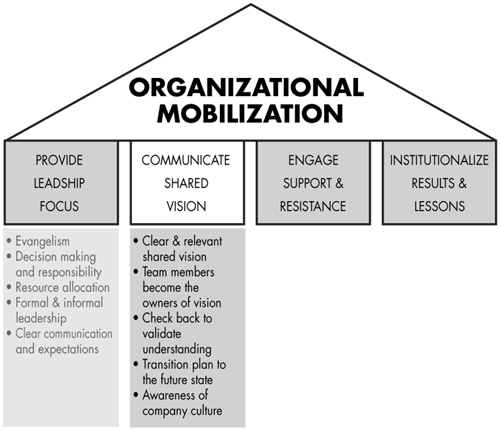Communicate Shared Vision
| The goals and the desired result of an RFID project, whether it is total supply chain visibility or better asset tracking, must be expressed to the whole team in a clear manner such that it generates energy and inspires the team to commit. The objective is to paint a picture in team members' minds so that they can see what the end-state looks like and see themselves in the future. That is considered a shared vision. Communicating this shared vision to all the team members is critical in successfully convincing the team to achieve the goal. The vision becomes truly shared when the team members feel ownership of the vision. At that point, the team becomes an example of organizational mobilization. Likewise, repeat communication about the shared vision is critical in making sure everyone is on-board with the business priorities. It is important to periodically check to see if stakeholders can articulate the same picture of the future shared state. Because achievement of the shared vision requires resources, it is important to ensure that the resource requirements are understood. Wal-Mart and the DoD are doing this with their extended team (suppliers) by holding summits for the suppliers, understanding the issues facing them and even adjusting the vision based on those issues (see Chapter 9, "Mandates as Business Catalysts").  If the shared vision is not communicated properly, it can lead to sub-optimal results. For example, if the team is not aligned with what the future state looks like, it is harder to convince someone to stay with the project through rough patches. An unclear or under-communicated vision can confuse people and increase their resistance to the RFID deployment. Another element to focus on in this stage is the transition path from the current state to the future one. Although team members may agree on the shared vision, the difficulties encountered in transitioning from the current to the future state may take them by surprise, resulting in a loss of initiative and teamwork when they are needed the most. For example, a consumer goods company moving from a barcode-based tracking system to a partial RFID-based tracking system (case and pallet level only, no item level) may have to sustain two systems for a significant period of timeone to read barcodes and the other to read RFID tags. In addition, fine-tuning the system to get accurate tracking of RFID-enabled packages may temporarily disrupt other operations or require diverting resources to the RFID pilot. This process is likely to increase quantity and complexity of the work performed by the operations staff. In addition, team members will see new activities affecting their daily work environment. Some of them may seem unrelated as they may not be able to tie each of the activities to the RFID project or understand the rationale for them. If they are not prepared for the increased workload, complexity, or added confusion, they are likely to see the project as "taking too long" or "not being as useful," and not give it their best. There are two things a team can do to mitigate this problem: address the context for change and account for the culture when making the plans. Showing people the context for change, whether it is market demand, regulations, or competitive pressure, and explaining to them how internal resources may be reallocated can help minimize their concerns during the transition period when many, seemingly unrelated, activities happen simultaneously. Focus on company culture is equally important. Some company cultures are more open to change than others. Some work best when the process change or process introduction is instigated from upper management, as opposed to others where grass roots initiatives work most effectively. Depending on the cultural dynamics, the team may have to make sure the right people are supporting the RFID deployment and showing the right type of support at various levels of the organization.
|
EAN: 2147483647
Pages: 112